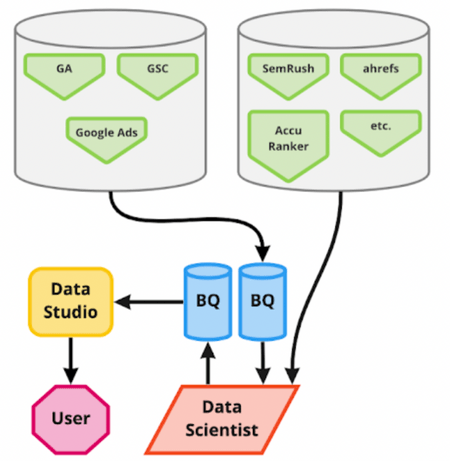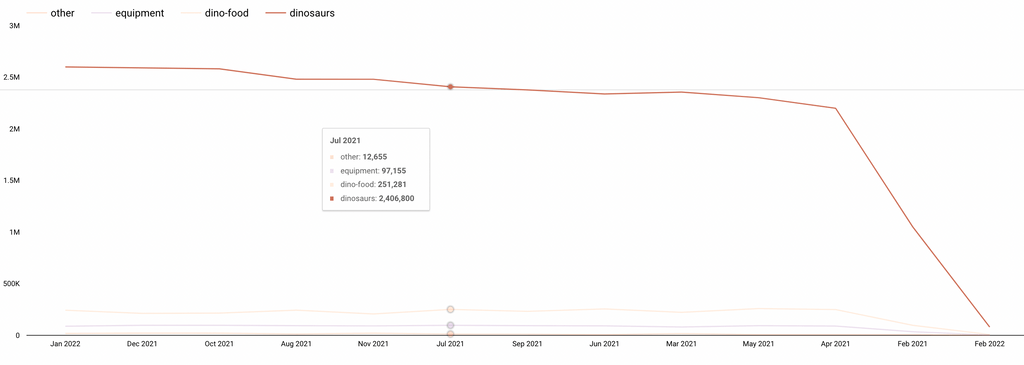Our eCommerce SEO process: what, why and how we do it
We’ve said it before, but we’ll say it again – as a business we’re only as good as our processes.
That’s because these processes are the core of what we offer our clients, and without strong, repeatable systems in place, it’s hard to deliver the quality and scale of work that we need to meet our goals, both internally and, most importantly, those of our clients.
The advantage of specialising in eCommerce – and particularly the DTC sector – is that we can map out these processes with a degree of confidence. We know what a typical project looks like, can spot common issues and roadblocks, and understand areas of opportunity. If we weren’t focused on one area, this would be more or less impossible.
The purpose of this article is to describe and show the reasoning behind the various stages and tasks that we carry out on a daily basis for our eCommerce clients. It’s these stages and tasks that help improve decision-making across the Blink SEO team, from those in delivery to account managers, strategists and management.
And this is an important point to make. Tight processes aren’t about just churning out work for the sake of it. Instead, the real benefit is that they allow us to prioritise more efficiently and give us the time and space to focus on the issues that really matter.
Let’s start with a visualisation of our process:
You can view the board in more detail here. It might seem a bit confusing at first glance, but the main point that should be noticeable is that everything is extremely front-loaded. But before we start looking at the various stages in more detail, it’s important to understand why this is the case.
High-impact work
Provided that a site can be crawled by a search engine, the factor that has the biggest impact on rankings is relevancy. When it comes to links, page speed and so on, another site with lower performance can still outrank yours if the query is more relevant.
This is partly why we talk so much about things like positioning and categorisation. Choosing keywords to target isn’t an arbitrary process based on search volume and competition, especially in the world of DTC. Instead the best results come when you align what’s unique about your brand with what people are actually searching for.
This isn’t something that’s made clear as much as it should be. For instance, let’s look at some high ranking SEO guides:
- https://ahrefs.com/blog/seo-basics/
- https://neilpatel.com/blog/simple-guide-to-seo/
- https://backlinko.com/seo-campaign
- https://keywordtool.io/blog/seo-campaign/
Most jump pretty quickly into keyword research as the first point of action. And this makes sense – before you can start executing a campaign, you need to know which terms you’re targeting. Yet, this is missing an entire layer of detail that’s crucial to the success of a project.
Here, “doing keyword research” is treated as some kind of self-contained activity – there’s often no mention of all the work that’s needed beforehand to make sure that it’s actually effective.
It’s hard to overstate this point. There are lots of agencies out there that say things like “we take the time to understand your business”, but nearly all of the time this is a surface-level glance. Without going much, much deeper, any campaign will largely be riding on sheer luck.
Understanding our client base
Some more context is valuable here. Most of the businesses we work with sell between £250,000 and £10 million per year. This is a market we know well, as it’s been our main focus for some time.
Each month, we run at least 40 or so of these projects, and we speak to their leadership teams on a daily basis. We understand the challenges they face, even if those challenges have little to do with digital marketing on the surface, such as shipping container costs or keeping the brands they stock happy.
At this size, most companies are either owner-managed, or may have a small marketing team. Either way, management will probably be wearing lots of hats. Product development, pricing, customer support, supply chains – all of this and more may be on their plate, as well as high-level responsibilities such as marketing strategies.
In larger organisations, of course, much of this is taken care of. There’s usually a marketing team that has gone through a detailed brand positioning exercise, and has access to user personas, pain points and all of the other background material that’s required.
For the kinds of businesses we work with, this often isn’t the case. Sometimes bits of the puzzle are in place, such as some initial audience research, or maybe a branding document, but nowhere near enough to achieve the kinds of numbers they’re looking for.
It’s obvious why this happens. Business owners don’t always come from a marketing background, especially in the world of eCommerce. They may not understand the steps needed to build the foundations of a strategy that’ll bring the results they need to stay viable.
In some of these circumstances, marketing managers might not even have this knowledge. Often, they’re promoted internally because they know the business and its audience well, not because they have an in-depth understanding of marketing channels and activity.
Regardless, there’s often not only a gap that needs filling, but sometimes a gap that no one can spot is even there in the first place.
It’s also worth noting that people come to us as a tactical solution – that is, they want more traffic and sales. All the strategic stuff that needs to go on before this can get missed.
This is why the client discovery portion of our onboarding process is so important. We can find out what’s present and what’s missing, and adjust our roadmap accordingly.
So, with all this in mind, what does our SEO strategy look like?
Phase one
We’ve already discussed the importance of gathering customer research and marketing resources as part of our discovery survey. If there are obvious gaps, we can either fill them ourselves or bring in an external partner if required. Either way, this information needs to be compiled or our high-impact tasks just won’t be effective.
At the same time though, there are a lot of other resources that we need to produce.
Much of the foundational work is based on our benchmark reporting. These are a series of Data Studio dashboards that have been built as part of a process developed by our Data Scientist, Dr Joshua Prettyman.
Here, various data sources are gathered by API, then processed and filtered to produce a subset of metrics and dimensions that meet the needs of our SEO team, including revenue by query. These are pushed into Google’s cloud storage solution, BigQuery, and then used as feeds for Data Studio.
These are:
Revenue overview
This includes a dashboard looking at metrics such as sales, traffic and product performance. This is a fairly standard overview that many similar agencies will produce.
Brand vs non-brand
This report is different in that it allows us to report on new metrics such as revenue by query and brand vs non-brand revenue.
Virtually all organic keyword data is hidden behind <not provided> in Google Analytics. This means that we can’t see which terms have driven traffic or revenue. For us and our clients, this is the information that really matters.
This can be a real blind spot for many businesses, particularly those in the DTC space. Without a clear idea of this mix, it can be muddy as to how campaigns are performing, or if they are at all.
For example, if most of your sales come from brand terms, this means that yours is an audience that already knows you. Growing this is going to be hard, and if traffic is stagnating, then this is probably why. On the other hand, largely non-brand sales can represent their own issues, with brand authority/market penetration an obvious one.
Either way, this visibility allows us to plan accordingly.
Falling/lost keywords
eCommerce sites are large and complicated, and create a huge amount of data. Unfortunately, most of this isn’t in a format that allows us to answer important questions. Even without bypassing <not provided>, the sheer number of keywords a normal eCommerce store is visible for makes using a normal rank tracker like Accuranker or something similar costly and unwieldy. One alternative is Search Console, but data is limited to 1,000 rows without API access.
Our approach gets around this and, combined with viewing revenue by query, this again helps us diagnose any issues and prioritise our work effectively.
Keyword tracker
As well as being able to track and easily sort, filter and analyse thousands of keywords at a time, we can also break keywords down into categories (more on this shortly) and position bands. This means we can spot trends over time that wouldn’t usually be apparent in a normal tracker.
Category performance
This is another report that’s built using our custom metrics.
Categorisation for many sites is really poor. Analytics has “product brand” and “product category” dimensions, but most sites don’t have this enabled. Of course, some stores have nice, neat file structures that can get around this.
Take this example:
www.we-sell-hats.com/mens-hats/bowler-hats/black/product-name
This is great. We could easily filter for “men’s hats”, “bowler hats” or “black hats” as categories. Most aren’t like this though. In reality the URL might look more like this:
www.we-sell-hats.com/product-name-black-bowler-hat
In this case, what should be standard reporting for metrics such as revenue, traffic and rankings by category then becomes a real pain.
With our approach, we aren’t reliant on URL structure or site taxonomy – instead, we define categories in BigQuery to be used as dimensions in our data sources. This means we can break these out and highlight changes, spot categories or subcategories that are rising or declining, and track revenue and keyword groupings over time.
Striking distance
This is much simpler. Here, we examine all keywords currently ranking in positions that are close to being likely to generate revenue. We can then identify opportunities for quick win optimisation.
VPI list
VPI (value, profitability and investment) is an important part of our prioritisation process.
As each benchmark document is reviewed by our SEO team, a list of recommendations is created. These are then assigned a score of high, medium or low for each of these factors, with value looking at potential impact; probability, at the confidence we have in its effectiveness; and investment, the time required to carry it out.
This list is then reviewed by our account management team and then built into the project roadmap.
Change log
This is a core part of our benchmarking process. All key updates – such as on-page optimisation, new content or technical fixes – are tracked and then used as annotations over key data, such as revenue and organic traffic. More general data, for example peak seasons and stock shortages, can also be included.
This gives context to our work, and allows us again to see what has had the greatest impact.
Phase two
Now we can move on to the most important task of all.
With all this information, we can then carry out keyword research that will target the phrases that not only stand the best chance of delivering traffic, but also sales.
From there, we can focus on creating the best site architecture to capitalise on this (including category and subcategory structure), supporting blog or informational content, and faceted navigations. We’ll cover this in more detail soon.
Phase three
Now that we know what we need to do, the focus moves on to getting it done.
This may require site sections to be built, or new ones wireframed and built from scratch. Large amounts of content may need to be created and delivered, or link-building campaigns set up and activated.
There are, of course, separate processes for all these, but the point remains that it’s much easier to carry out all this work once the foundations have been laid.
Phase four
With everything benchmarked in the first phase, we can now easily review the impact of our work. At this point, essentially the whole process starts again as we examine what’s been effective, what hasn’t, and where the VPI system says we should prioritise next.
Technical auditing
Technical SEO hasn’t had much of a mention so far. This is intentional – this is a vast subject in itself, with a wide range of its own specialist processes.
This is why we treat it as its own distinct workflow that runs in parallel with the main SEO process. While there will sometimes be some interdependencies, this means we can avoid unnecessary delays.
And there it is, our SEO process from start to – well, it’s never really finished.
As well as the loop of experimentation and measurement never closing, we’re obviously continuing to refine these processes as we go along. If you’d like to know more about how (or why) we do things at Blink, get in touch.
Get in touch
Have a problem that Blink can help with? Let us know more about your project below and we’ll be in contact as soon as we can.



